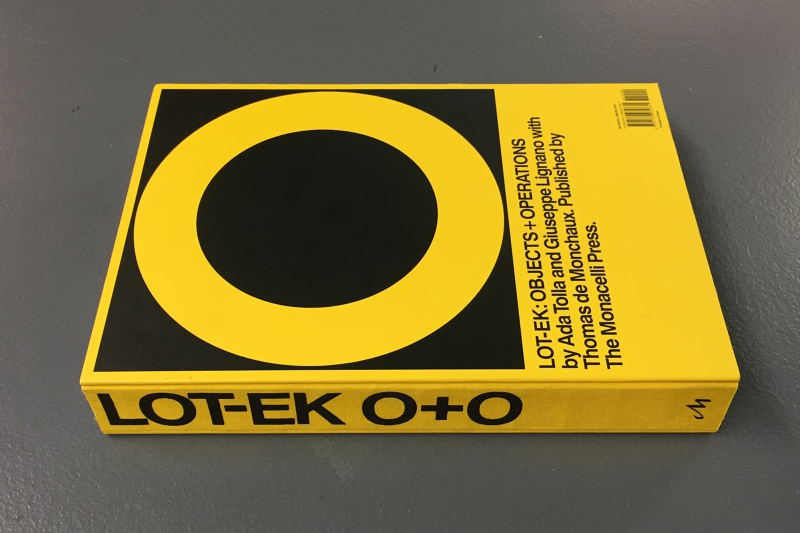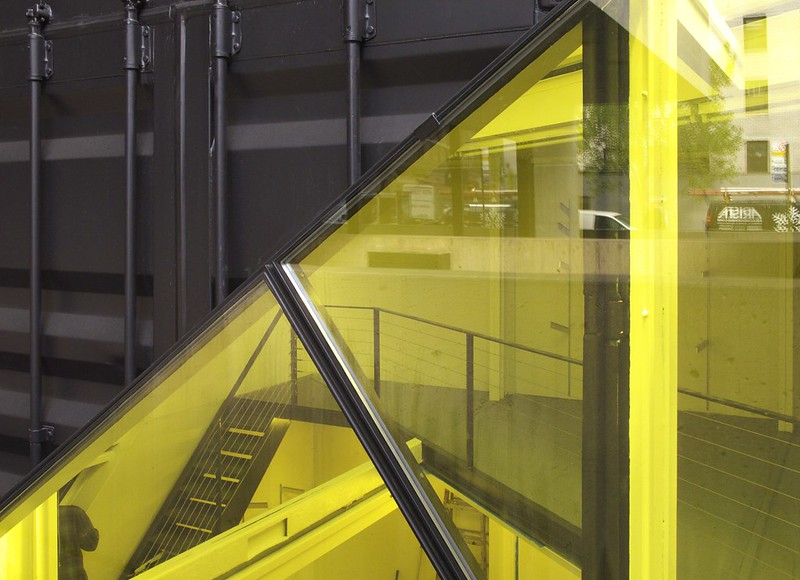Book Review: LOT-EK: Objects and Operations
LOT-EK: Objects + Operations by Ada Tolla and Giuseppe Lignano with Thomas de Monchaux, published by The Monacelli Press, 2017. Hardcover, 400 pages. (Amazon)

[Cover via LOT-EK]
If one architecture firm deserves credit for sticking to its guns, it's LOT-EK. The duo of Ada Tolla and Giuseppe Lignano has incorporated industrial detritus – primarily shipping containers – into their built and unbuilt projects for around a couple decades. Other architects have exploited the potential of inexpensive shipping containers, but none have done it so thoroughly and repeatedly. Projects like the 2008 Wiener Townhouse in the West Village, which I included in my book Guide to Contemporary New York City Architecture, look to have abandoned the reuse of industrial parts, only to subtly reveal they are built with truck containers and ducts. About ten years later, LOT-EK has just completed Drivelines in Johannesburg, a live-work building made from dozens of "upcycled ISO shipping containers."

[Whitney Studio, 2012 | Photo by John Hill]
Objects + Operations, the duo's second monograph, focuses on works this century, be they "built, unbuilt, and in-progress; polemical, practical, and in-between." One thing I'm always drawn to with monographs is organization. Instead of organizing their projects by date, typology, or geography, LOT-EK opts for color: "Projects are sequenced along a spectrum of color, starting and ending at yellow." The choice of yellow is not surprising, given the cover of their first book, the way they use the color repeatedly, and the way yellow peppers much of the "industrial" urban environment: road signs, school buses, construction equipment, etc. But like the shipping containers they use so frequently, color is an important element: something to distinguish one container from another, one project from another, one place from another.
With color at its core, one could feasibly find a LOT-EK project by flipping through the book and landing in the right part of the spectrum. The Bohen Foundation, one of the few LOT-EK projects I've experienced in person, is red and therefore found in the first half of the book, between the orange and pink projects. The very yellow Van Alen Books, a temporary space I still miss, completes the book, a fitting place in my sentimental mind.

[Spread from book via LOT-EK]
But the book is not all projects. First, their works are situated alongside "Urban Scan," black-and-white photos that document urban environments; they are organized by geometry since color is not an option with these images. (LOT-EK's Instagram is a great place to keep up on their "scanning" of New York and other cities.) Second are short, one-page "interviews" – more conversations or statements than interviews – that express how the couple thinks and acts. Third and last are essays by co-author Thomas de Monchaux that "flow throughout the objects section of the book in seven distinct chapters." In the spread above, for instance, the documentation of Apap Open School is on the left, while an "Urban Scan" photo is on the right, above part of de Monchaux's text for his "LOT-EK" essay.
This approach to organizing and presenting the materials that make up LOT-EK's second monograph – this intertwining of four strands of content (projects, interviews, essays, and b/w images) – ultimately prioritizes gradient over compartmentalization, the latter being the norm in most monographs. But in LOT-EK's hands the monograph is a means of situating the reader within their world. Open the book to any page and the reader is confronted with a color (project) and a shape (scan), each a part of a gradient/spectrum that opens and closes in the same color and shape: yellow and circle. So readers are always oriented within the book's content, and therefore within LOT-EK's unique way of looking at the urban environment and their means of responding to it through their projects.
[Cover via LOT-EK]
If one architecture firm deserves credit for sticking to its guns, it's LOT-EK. The duo of Ada Tolla and Giuseppe Lignano has incorporated industrial detritus – primarily shipping containers – into their built and unbuilt projects for around a couple decades. Other architects have exploited the potential of inexpensive shipping containers, but none have done it so thoroughly and repeatedly. Projects like the 2008 Wiener Townhouse in the West Village, which I included in my book Guide to Contemporary New York City Architecture, look to have abandoned the reuse of industrial parts, only to subtly reveal they are built with truck containers and ducts. About ten years later, LOT-EK has just completed Drivelines in Johannesburg, a live-work building made from dozens of "upcycled ISO shipping containers."

[Whitney Studio, 2012 | Photo by John Hill]
Objects + Operations, the duo's second monograph, focuses on works this century, be they "built, unbuilt, and in-progress; polemical, practical, and in-between." One thing I'm always drawn to with monographs is organization. Instead of organizing their projects by date, typology, or geography, LOT-EK opts for color: "Projects are sequenced along a spectrum of color, starting and ending at yellow." The choice of yellow is not surprising, given the cover of their first book, the way they use the color repeatedly, and the way yellow peppers much of the "industrial" urban environment: road signs, school buses, construction equipment, etc. But like the shipping containers they use so frequently, color is an important element: something to distinguish one container from another, one project from another, one place from another.
With color at its core, one could feasibly find a LOT-EK project by flipping through the book and landing in the right part of the spectrum. The Bohen Foundation, one of the few LOT-EK projects I've experienced in person, is red and therefore found in the first half of the book, between the orange and pink projects. The very yellow Van Alen Books, a temporary space I still miss, completes the book, a fitting place in my sentimental mind.

[Spread from book via LOT-EK]
But the book is not all projects. First, their works are situated alongside "Urban Scan," black-and-white photos that document urban environments; they are organized by geometry since color is not an option with these images. (LOT-EK's Instagram is a great place to keep up on their "scanning" of New York and other cities.) Second are short, one-page "interviews" – more conversations or statements than interviews – that express how the couple thinks and acts. Third and last are essays by co-author Thomas de Monchaux that "flow throughout the objects section of the book in seven distinct chapters." In the spread above, for instance, the documentation of Apap Open School is on the left, while an "Urban Scan" photo is on the right, above part of de Monchaux's text for his "LOT-EK" essay.
This approach to organizing and presenting the materials that make up LOT-EK's second monograph – this intertwining of four strands of content (projects, interviews, essays, and b/w images) – ultimately prioritizes gradient over compartmentalization, the latter being the norm in most monographs. But in LOT-EK's hands the monograph is a means of situating the reader within their world. Open the book to any page and the reader is confronted with a color (project) and a shape (scan), each a part of a gradient/spectrum that opens and closes in the same color and shape: yellow and circle. So readers are always oriented within the book's content, and therefore within LOT-EK's unique way of looking at the urban environment and their means of responding to it through their projects.
Comments
Post a Comment
Comments are moderated for spam.